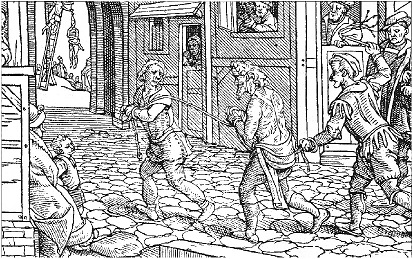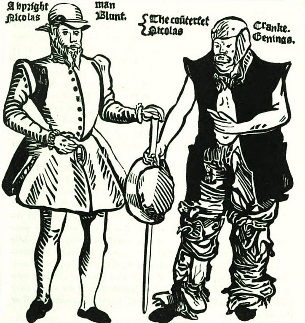
The Poor

Introduction
 In your imaginary trip round London in lesson 2, one of the scenes you 'saw' was a 'sturdy' beggar being whipped through the streets.
In your imaginary trip round London in lesson 2, one of the scenes you 'saw' was a 'sturdy' beggar being whipped through the streets.
This lesson looks in more detail at what it was like to be poor in the Early Modern Age.
In the sixteenth century many people lived in a state of poverty that we find almost impossible to imagine.
There was no Welfare State or Social Security. People who could not earn enough to support themselves were forced to beg.
In 1598, the government passed a Poor Law. Local churches were told to appoint 'overseers' to look after the poor. The area looked after by each church was called a parish.
• The Impotent Poor (helpless people such as the old and blind) were to be paid a small amount of money by the parish, or given a licence to beg.
• The Poor by Casualty (such as wounded soldiers and sick people) were to be put in the parish workhouse.
• The Idle Poor (or 'sturdy beggars') were to be whipped or hanged.
After you have studied this webpage, answer the question sheet by clicking on the 'Time to Work' icon at the top of the page.
Links:
The following websites will help you research further:
Everyday Life:
• BBC Bitesize - excellent
•
BBC audio clip on Rich and Poor in Tudor times (rather silly)
![]()
1 A Servant's Will
This is the Will of Margerye Brankingham of County Durham, 1573. Margerye Brankingham was NOT a beggar but this was all she owned. Mouseover the words in brown bold to see what they mean.
Pan and dubbler to Agnes Stevenson.
2 yards of black cloth to Elizabeth Robinson, whereof I purposed to have made me a gown.
The rest I do whollye give unto John Robinson my master.
Her possessions:
• A brasse potte and panne and two pewter dubblers. 9s
• Of lynnen, 2 worne codwaynes, a rayle, a chirecheife, smock and a towel. 2s 9d
• 2 yards of black cloth which should have been her coat. 8s 8d
• 2 old worne coats. 3s 4d
• An hatte, and an old bedde coverlet. 3s 4d
2 Tudor beggars
 In 1592, Thomas Harman published A Warning for Vagabonds, about fake beggars who would trick you out of your money.
In 1592, Thomas Harman published A Warning for Vagabonds, about fake beggars who would trick you out of your money.
The picture shows:
• Bright Nicholas, who pretended to be an 'upright gentleman' down on his luck.
• A soap eater, who ate soap to make himself froth at the mouth as if he had epilepsy.
Other kinds of sturdy beggars included:
• Tom O'Bedlam (pretended to be mad).
• Whipjacks (pretended to be old sailors).
• Drummerers (pretended to be deaf).
3 The Trouble with Beggars
From a letter written in 1596 by Edward Hext, a Justice of the Peace. 1596 was a time of famine in England.
This year there assembled 80 rogues who stole a whole load of cheese . . . .
I say that the large numbers of idle, wandering people and robbers are the chief cause of the food shortage, for they do not work but lie idly in ale-houses day and night, eating and drinking too much . . . .
And when they are put in jail, the poor country people they robbed are forced to feed them.
4 Two Beggar-girls
From the Register of the Parish of Newtimber, 1615.
Alice and Elizabeth Pickering, wandering children, were whipped according to the law, and sent with a pass to Shrewsbury, the place where they were born.